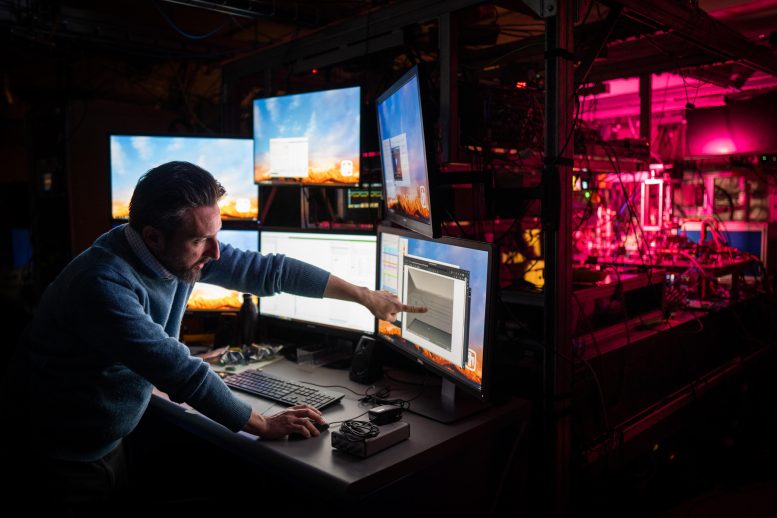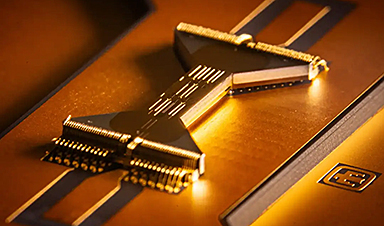Sandia Labs manufactures its first devices capable of supporting 200 trapped ion qubits.
Sandia National Laboratories has produced its first lot of a new world-class ion trap, a central component for certain quantum computers. This innovative device, termed the Enchilada Trap, enables researchers to construct more powerful machines, propelling the experimental yet groundbreaking realm of quantum computing forward.
In addition to traps operated at Sandia, several traps will be used at Duke University for performing quantum algorithms. Duke and Sandia are research partners through the Quantum Systems Accelerator, one of five U.S. National Quantum Information Science Research Centers funded by the Department of Energy’s Office of Science.
An ion trap is a type of microchip that holds electrically charged atoms, or ions. With more trapped ions, or qubits, a quantum computer can run more complex algorithms.

Jonathan Sterk points to the section of an ion trap trapped ion qubits travel in a close-up view of the trap inside a vacuum chamber at Sandia National Laboratories. Credit: Craig Fritz, Sandia National Laboratories
With sufficient control hardware, the Enchilada Trap could store and transport up to 200 qubits using a network of five trapping zones inspired by its predecessor, the Roadrunner Trap. Both versions are produced at Sandia’s Microsystems Engineering, Science, and Applications fabrication facility.
According to Daniel Stick, a Sandia scientist and leading researcher with the Quantum Systems Accelerator, a quantum computer with up to 200 qubits and current error rates will not outperform a conventional computer for solving useful problems. However, it will enable researchers to test an architecture with many qubits that in the future will support more sophisticated quantum algorithms for physics, chemistry, data science, materials science, and other areas.
“We are providing the field of quantum computing room to grow and explore larger machines and more complicated programming,” Stick said.
Sandia National Laboratories electrical engineer Ray Haltli optimizes parameters before placing gold wire bonds on an ion trap. When ready, the machine runs automatically, placing up to seven wires per second. Credit: Craig Fritz, Sandia National Laboratories
A forward-looking design
Sandia has researched, built, and tested ion traps for 20 years. To overcome a series of design challenges, the team combined institutional knowledge with new innovations.
For one, they needed space to hold more ions and a way to rearrange them for complex calculations. The solution was a network of electrodes that branches out similar to a family tree or tournament bracket. Each narrow branch serves as a place to store and shuttle ions.
Sandia had experimented with similar junctions in previous traps. The Enchilada Trap uses the same design in a tiled way so it can explore scaling properties of a smaller trap. Stick believes the branching architecture is currently the best solution for rearranging trapped ion qubits and anticipates that future, even larger versions of the trap will feature a similar design.
Another concern was the dissipation of electrical power on the Enchilada Trap, which could generate significant heat, leading to increased outgassing from surfaces, a higher risk of electrical breakdown, and elevated levels of electrical field noise. To address this issue, production specialists designed new microscopic features to reduce the capacitance of certain electrodes.
“Our team is always looking ahead,” said Sandia’s Zach Meinelt, the lead integrator on the project. “We collaborate with scientists and engineers to learn about the kind of technology, features, and performance improvements they will need in the coming years. We then design and fabricate traps to meet those requirements and constantly seek ways to further improve.”
The research was funded by the US Department of Energy.
News
Repurposed drugs could calm the immune system’s response to nanomedicine
An international study led by researchers at the University of Colorado Anschutz Medical Campus has identified a promising strategy to enhance the safety of nanomedicines, advanced therapies often used in cancer and vaccine treatments, [...]
Nano-Enhanced Hydrogel Strategies for Cartilage Repair
A recent article in Engineering describes the development of a protein-based nanocomposite hydrogel designed to deliver two therapeutic agents—dexamethasone (Dex) and kartogenin (KGN)—to support cartilage repair. The hydrogel is engineered to modulate immune responses and promote [...]
New Cancer Drug Blocks Tumors Without Debilitating Side Effects
A new drug targets RAS-PI3Kα pathways without harmful side effects. It was developed using high-performance computing and AI. A new cancer drug candidate, developed through a collaboration between Lawrence Livermore National Laboratory (LLNL), BridgeBio Oncology [...]
Scientists Are Pretty Close to Replicating the First Thing That Ever Lived
For 400 million years, a leading hypothesis claims, Earth was an “RNA World,” meaning that life must’ve first replicated from RNA before the arrival of proteins and DNA. Unfortunately, scientists have failed to find [...]
Why ‘Peniaphobia’ Is Exploding Among Young People (And Why We Should Be Concerned)
An insidious illness is taking hold among a growing proportion of young people. Little known to the general public, peniaphobia—the fear of becoming poor—is gaining ground among teens and young adults. Discover the causes [...]
Team finds flawed data in recent study relevant to coronavirus antiviral development
The COVID pandemic illustrated how urgently we need antiviral medications capable of treating coronavirus infections. To aid this effort, researchers quickly homed in on part of SARS-CoV-2's molecular structure known as the NiRAN domain—an [...]
Drug-Coated Neural Implants Reduce Immune Rejection
Summary: A new study shows that coating neural prosthetic implants with the anti-inflammatory drug dexamethasone helps reduce the body’s immune response and scar tissue formation. This strategy enhances the long-term performance and stability of electrodes [...]
Scientists discover cancer-fighting bacteria that ‘soak up’ forever chemicals in the body
A family of healthy bacteria may help 'soak up' toxic forever chemicals in the body, warding off their cancerous effects. Forever chemicals, also known as PFAS (per- and polyfluoroalkyl substances), are toxic chemicals that [...]
Johns Hopkins Researchers Uncover a New Way To Kill Cancer Cells
A new study reveals that blocking ribosomal RNA production rewires cancer cell behavior and could help treat genetically unstable tumors. Researchers at the Johns Hopkins Kimmel Cancer Center and the Department of Radiation Oncology and Molecular [...]
AI matches doctors in mapping lung tumors for radiation therapy
In radiation therapy, precision can save lives. Oncologists must carefully map the size and location of a tumor before delivering high-dose radiation to destroy cancer cells while sparing healthy tissue. But this process, called [...]
Scientists Finally “See” Key Protein That Controls Inflammation
Researchers used advanced microscopy to uncover important protein structures. For the first time, two important protein structures in the human body are being visualized, thanks in part to cutting-edge technology at the University of [...]
AI tool detects 9 types of dementia from a single brain scan
Mayo Clinic researchers have developed a new artificial intelligence (AI) tool that helps clinicians identify brain activity patterns linked to nine types of dementia, including Alzheimer's disease, using a single, widely available scan—a transformative [...]
Is plastic packaging putting more than just food on your plate?
New research reveals that common food packaging and utensils can shed microscopic plastics into our food, prompting urgent calls for stricter testing and updated regulations to protect public health. Beyond microplastics: The analysis intentionally [...]
Aging Spreads Through the Bloodstream
Summary: New research reveals that aging isn’t just a local cellular process—it can spread throughout the body via the bloodstream. A redox-sensitive protein called ReHMGB1, secreted by senescent cells, was found to trigger aging features [...]
AI and nanomedicine find rare biomarkers for prostrate cancer and atherosclerosis
Imagine a stadium packed with 75,000 fans, all wearing green and white jerseys—except one person in a solid green shirt. Finding that person would be tough. That's how hard it is for scientists to [...]
Are Pesticides Breeding the Next Pandemic? Experts Warn of Fungal Superbugs
Fungicides used in agriculture have been linked to an increase in resistance to antifungal drugs in both humans and animals. Fungal infections are on the rise, and two UC Davis infectious disease experts, Dr. George Thompson [...]






















